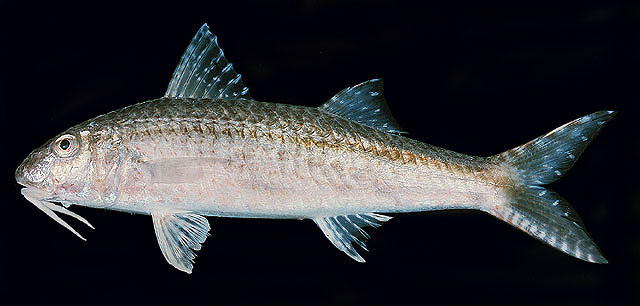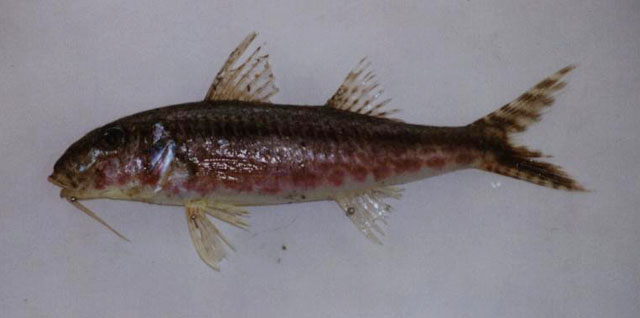
Upeneus pori Ben-Tuvia & Golani, 1989
Body elongated, with a rounded snout. Color greyish or red-brown, darker on the back, and covered with grey or reddish brown spots. There is a dark brown or red bar which runs vertically through the eye and the barbels located on the chin are white or yellow. Tail marked with a total of 11–15 bars with 4–6 reddish brown bars on the upper lobe and 6–9 red-brown or grey bars on the lower part of the lower lobe which extend to form a broad brown or dark grey stripe along middle of lobe. There are also 3–4 brownish-red or grey bars on inner, upper half of lower lobe.
Corsini, M., Margies, P., Kondilatos, G., Economidis, P.S. (2005). Lessepsian migration of fishes to the Aegean Sea: First record of Tylerius spinosissimus (Tetraodontidae) from the Mediterranean and six more fish records from Rhodes. Cybium 29: 347-354.
2003
UNA
Por’s goatfish
It can be found in shallow littoral zone to 52 m depth. Feeds on hypobenthic invertebrates, mainly crustaceans and, to a lesser extent, polychaetes, which they detect with their barbels.
No impact on biodiversity has been reported to date. Yet, potential competition with the native Mullus barbatus and M. surmuletus, might lead to native species’ extirpation.
No impact on health and ecosystem services has been reported to date. Nevertheless, extirpation of native mullids, which are highly commercial, might impact fisheries. On the other hand, since U. pori is edible, it might become an additional source of income for the local fishers. Indeed, in some areas it is sold along with the native M. surmuletus.
Yes
No
Records of Upeneus pori
Sites where Upeneus pori has been recorded in the Hellenic Seas.



ISO 9001
: Το Κλειδί για την Επιτυχία και την Ανάπτυξη Μιας Επιχείρησης
Το ISO 9001 αποτελεί ένα από τα πιο διαδεδομένα και σημαντικά πρότυπα διαχείρισης ποιότητας παγκοσμίως. Δεν είναι απλώς ένα πιστοποιητικό, αλλά ένα εργαλείο που μπορεί να μεταμορφώσει τη λειτουργία μιας επιχείρησης. Ας δούμε γιατί κάθε εταιρεία πρέπει να το αποκτήσει και ποια βήματα πρέπει να ακολουθήσει για να το πετύχει.
Τι είναι το ISO 9001;
Το ISO 9001 είναι ένα διεθνές πρότυπο που καθορίζει τις απαιτήσεις για την ανάπτυξη και την εφαρμογή ενός Συστήματος Διαχείρισης Ποιότητας (ΣΔΠ). Σκοπός του είναι η βελτίωση των λειτουργιών της επιχείρησης, η ικανοποίηση των πελατών και η διασφάλιση συνέπειας στην ποιότητα των προϊόντων ή υπηρεσιών που παρέχονται.
Το ISO 9001 είναι ευέλικτο και μπορεί να εφαρμοστεί σε κάθε τύπο επιχείρησης, ανεξαρτήτως μεγέθους ή τομέα δραστηριότητας. Δεν περιορίζεται σε έναν συγκεκριμένο κλάδο, καθιστώντας το ιδανικό για οργανισμούς που θέλουν να ξεχωρίσουν στον ανταγωνισμό.
Γιατί είναι Απαραίτητο το ISO 9001 για Μια Εταιρεία;
Βελτίωση Ποιότητας
Με την εφαρμογή του ISO 9001, η επιχείρηση θέτει ένα σταθερό πλαίσιο για την ανάπτυξη προϊόντων και υπηρεσιών υψηλής ποιότητας.
Ενίσχυση Εμπιστοσύνης Πελατών
Οι πελάτες προτιμούν εταιρείες που τηρούν διεθνή πρότυπα ποιότητας. Το ISO 9001 ενισχύει την εικόνα μιας επιχείρησης, αυξάνοντας την αξιοπιστία της.
Συμμόρφωση με Κανονισμούς
Το πρότυπο βοηθά τις εταιρείες να συμμορφώνονται με τις νομικές και κανονιστικές απαιτήσεις, ελαχιστοποιώντας τον κίνδυνο προστίμων ή νομικών επιπλοκών.
Μείωση Κόστους
Η τυποποίηση των διαδικασιών μειώνει τις απορρίψεις και τα λάθη, οδηγώντας σε εξοικονόμηση πόρων και χρόνου.
Ανταγωνιστικό Πλεονέκτημα
Η πιστοποίηση ISO 9001 συχνά αποτελεί βασική προϋπόθεση για τη συμμετοχή σε διαγωνισμούς ή για συνεργασίες με μεγάλες εταιρείες.
Εργαλείο Ανάπτυξης
Το πρότυπο ενισχύει τη λειτουργική αποδοτικότητα και προάγει την καινοτομία, επιτρέποντας στις επιχειρήσεις να αναπτυχθούν.
Πώς Μπορεί μια Εταιρεία να Αποκτήσει το ISO 9001;
Η διαδικασία απόκτησης του ISO 9001 απαιτεί στρατηγική προετοιμασία και οργάνωση.
1. Αρχική Αξιολόγηση
Η εταιρεία πρέπει να αναλύσει τις υπάρχουσες διαδικασίες της για να εντοπίσει τυχόν κενά σε σχέση με τις απαιτήσεις του προτύπου.
2. Εκπαίδευση και Ευαισθητοποίηση
Όλα τα μέλη της επιχείρησης, από τη διοίκηση μέχρι το προσωπικό, πρέπει να κατανοήσουν τη σημασία του ISO 9001 και τον ρόλο τους στην εφαρμογή του.
3. Σχεδιασμός και Εφαρμογή του Συστήματος Διαχείρισης Ποιότητας
Η εταιρεία αναπτύσσει και τεκμηριώνει το ΣΔΠ, περιλαμβάνοντας διαδικασίες, πολιτικές και στόχους που ανταποκρίνονται στις απαιτήσεις του προτύπου.
4. Προετοιμασία για Έλεγχο
Πριν από την πιστοποίηση, πραγματοποιούνται εσωτερικοί έλεγχοι για να διασφαλιστεί η συμμόρφωση του συστήματος.
5. Πιστοποίηση από Διαπιστευμένο Φορέα
Η εταιρεία επιλέγει έναν αξιόπιστο φορέα πιστοποίησης για την πραγματοποίηση του τελικού ελέγχου και την απονομή του ISO 9001.
6. Διαρκής Βελτίωση
Η εφαρμογή του ISO 9001 δεν είναι στατική. Απαιτεί συνεχή αξιολόγηση και βελτίωση για να διασφαλιστεί η αποτελεσματικότητα του ΣΔΠ.
Συμπέρασμα
Το ISO 9001 δεν είναι απλώς ένα ακόμη πιστοποιητικό. Είναι μια επένδυση που βοηθά τις επιχειρήσεις να ξεχωρίσουν, να αποκτήσουν εμπιστοσύνη από τους πελάτες τους και να επιτύχουν μακροπρόθεσμη βιώσιμη ανάπτυξη. Με τη σωστή προετοιμασία και δέσμευση, κάθε εταιρεία μπορεί να το αποκτήσει και να επωφεληθεί από τα πλεονεκτήματα που προσφέρει.
Ξεκινήστε σήμερα, βάζοντας τα θεμέλια για ένα μέλλον γεμάτο επιτυχίες.